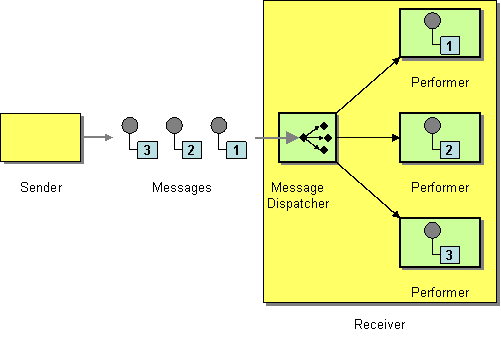Since we're on a major migration process of this website, some component documents here are out of sync right now. In the meantime you may want to look at the early version of the new website
https://camel.apache.org/staging/
We would very much like to receive any feedback on the new site, please join the discussion on the Camel user mailing list.
Message DispatcherCamel supports the Message Dispatcher from the EIP patterns using various approaches. You can use a component like JMS with selectors to implement a Selective Consumer as the Message Dispatcher implementation. Or you can use an Endpoint as the Message Dispatcher itself and then use a Content Based Router as the Message Dispatcher.
ExampleThe following example demonstrates Message Dispatcher pattern using the Competing Consumers functionality of the JMS component to offload messages to a Content Based Router and custom Processors registered in the Camel Registry running in separate threads from originating consumer.
Using the Fluent Builders from("jms:queue:foo?concurrentConsumers=5")
.threads(5)
.choice()
.when(header("type").isEqualTo("A"))
.processRef("messageDispatchProcessorA")
.when(header("type").isEqualTo("B"))
.processRef("messageDispatchProcessorB")
.when(header("type").isEqualTo("C"))
.processRef("messageDispatchProcessorC")
.otherwise()
.to("jms:queue:invalidMessageType");
Using the Spring XML Extensions <route>
<from uri="jms:queue:foo?concurrentConsumers=5"/>
<threads poolSize="5">
<choice>
<when>
<simple>${in.header.type} == 'A'</simple>
<to ref="messageDispatchProcessorA"/>
</when>
<when>
<simple>${in.header.type} == 'B'</simple>
<to ref="messageDispatchProcessorB"/>
</when>
<when>
<simple>${in.header.type} == 'C'</simple>
<to ref="messageDispatchProcessorC"/>
</when>
<otherwise>
<to uri="jms:queue:invalidMessageType"/>
</choice>
</threads>
</route>
See Also
Using This PatternIf you would like to use this EIP Pattern then please read the Getting Started, you may also find the Architecture useful particularly the description of Endpoint and URIs. Then you could try out some of the Examples first before trying this pattern out. |

